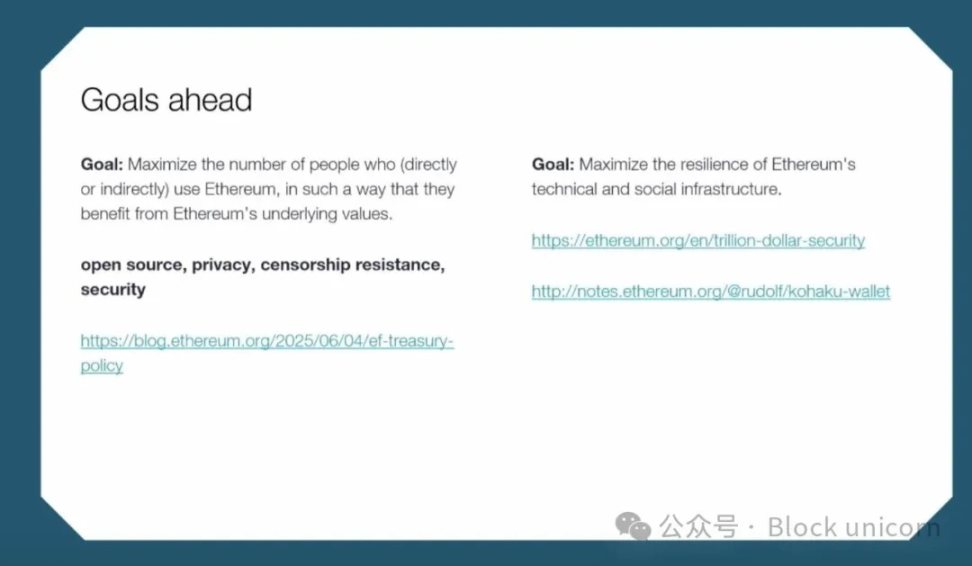Foreword
Ethereum has been at a crossroads over the past few years.
Increasing criticism has led to a change in leadership at the Foundation and hopefully a broader review to increase transparency and engagement, and a stronger focus on value capture at the L1 level.
Previously, it was rare to see the Executive Director speaking on multiple panels at Ethereum conferences. This week, I was pleased to see Tomasz K. Stańczak (Co-Executive Director of the Ethereum Foundation) participating in as many events and panels as possible.
It was really refreshing and hopefully a sign of things to come.
So… what is the future vision for Ethereum?
How can we ensure that this vision is well executed?
This article provides an overview of the Ethereum vision.
Goals
To have a structured vision, you must start with goals.

For Ethereum, the main goals are as follows:
1. Return to the spirit of encryption, how to protect privacy and trustless features.
It's not just about attracting new users, but making sure they can take advantage of these values and spirit and build on them.
Build, yes, but with purpose and values.
2. Ensure Ethereum remains the most secure and resilient blockchain infrastructure.
This echoes Vitalik’s post on “Securing a Trillion Dollars”.
This is part of a broader discussion about security:
How do we improve the security of Ethereum?
How do we adequately communicate this to users?
How do we ensure that both institutions and users can take full advantage of this?
Most importantly:
How do we ensure that all technical developments continue to uphold the core spirit and values of Ethereum? No shortcuts, no compromises.
Recently, many people have blamed Ethereum and have become somewhat alienated from developers.
However, this situation seems to be about to change.
In fact, we can expect the Ethereum Foundation to take a slightly more active approach and develop a new funding policy. Thomas said that this will be used to explore efficient and durable DeFi protocols and strategically allocate funds to them, moving from a passive approach to guided management.
This is just one of a number of challenges that will have a profound impact on the long-term future of Ethereum, including:
Regulatory clarity
AI adoption
Privacy issues

Among these, a key aspect and a major recent trend is the increase in institutional adoption.

The future vision of Ethereum is to treat various fields and industries as modular components, make them open source and remove intermediaries.

In turn, these modules will ensure a smooth transition from Web2 to Web3, eliminating friction between institutions.
Imagine that health institutions in different countries are able to open and contribute to health data repositories. All of this is secured through interactions on the Ethereum chain, guaranteeing the security and verifiability of these solutions.
The ultimate goal? Allow users to trade all assets around the world on the chain.
Challenges
However, to achieve this goal, Ethereum needs to solve some of the main challenges and confusions faced by users.

Therefore, the focus in the future will be on solving some of the main challenges of on-chain privacy and identity identification, and addressing the threats of AI by establishing Ethereum as a trusted layer for AI execution.
All of this will create a diverse environment and build a social structure that enables different actors to collaborate, with the ultimate goal of making Ethereum an anti-fragile network.
To truly resist centralization, it is necessary to ensure participation from around the world and incorporate multiple voices and approaches to build a truly global network.

This will enable Ethereum to listen to important issues and empower pluralism and diversity.
It was also refreshing to hear about the tension between L1 and L2, with the Ethereum Foundation making it clear that there is no opposition between them.
Rather, Ethereum will be more actively guiding how to ensure these L2s reach Phase 2, protecting users through Ethereum as the underlying base layer.

Last but not least, we are seeing the emergence of live blockchains like MegaETH, and other fast networks like Monad and Hyperliquid.
This also raises questions about interoperability and integration:

Therefore, new tools need to be introduced to verify at what level new challenges can be identified and ensure that clients can integrate with these networks.
This opens up a new creative space for client development.
All Ethereum client teams have agreed to 45 million or even 60 million gas per block, with the goal of reaching 100 million gas by the end of this year or the first quarter of next year.
Internal reorganization will help achieve this goal, with modular teams working on common goals:
Expand L1
Expand Blob
Improve user experience
Improve interoperability
You heard it right: expanding L1 (a previously neglected area) is one of these goals.

I am personally optimistic about Ethereum, welcome this awakening, and hope to see its further progress.
 Alex
Alex
 Alex
Alex Clement
Clement Catherine
Catherine Kikyo
Kikyo Clement
Clement Catherine
Catherine Clement
Clement Joy
Joy Clement
Clement Davin
Davin